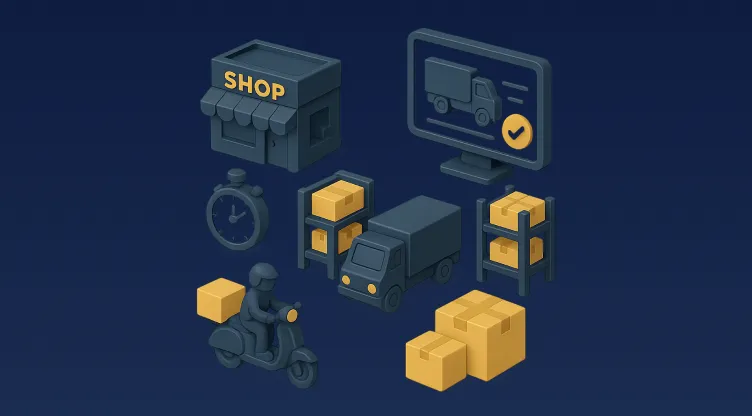In today’s digital-first economy, customer expectations are rapidly evolving. One of the most significant shifts is the demand for near-instant delivery of goods. What started with e-commerce giants offering two-day shipping has now transformed into quick commerce (Q-commerce) where deliveries are promised in a matter of hours, sometimes even minutes. This trend is reshaping retail, supply chains, and logistics at a fundamental level. At the heart of this transformation lies the Warehouse Management System (WMS), a critical technology that makes same-day delivery possible.
The Growth of Quick Commerce
Quick commerce is growing at an unprecedented pace, driven by consumer demand for speed, convenience, and flexibility. From groceries and medicines to electronics and apparel, customers want products delivered faster than ever before. According to industry reports, the global Q-commerce market is projected to grow in double digits annually, with India and Southeast Asia emerging as hotbeds for this trend.
Retailers, startups, and even traditional businesses are entering this space to stay relevant. However, the promise of same-day or ultra-fast delivery isn’t just about speed. It requires precision, efficiency, and real-time visibility across the supply chain. That’s where WMS steps in as the backbone of fulfillment operations.
Why WMS is Crucial for Same-Day Delivery
A Warehouse Management System is no longer a back-office tool; it’s the engine that drives fulfillment excellence. In the world of Q-commerce, where every minute matters, WMS enables businesses to meet customer expectations through:
1. Real-Time Inventory Visibility
Quick commerce relies on accurate and immediate inventory updates. A modern WMS integrates with multiple sales channels, ensuring that customers see only what’s available in real time. This prevents stockouts, order cancellations, and disappointed customers.
2. Intelligent Order Routing
Same-day delivery requires smart order allocation. WMS uses advanced algorithms to route orders to the closest warehouse, dark store, or micro-fulfillment center. This minimizes transit times and reduces logistics costs.
3. Optimized Picking and Packing
Traditional picking processes are too slow for Q-commerce. WMS optimizes picking routes, supports batch picking, and leverages automation like pick-to-light or voice picking. This ensures that products move from shelf to dispatch in record time.
4. Seamless Last-Mile Integration
The last mile is often the most expensive and complex part of the delivery chain. WMS integrates with last-mile delivery platforms, enabling businesses to assign drivers, track shipments, and provide customers with real-time updates—all essential for meeting same-day delivery promises.
5. Data-Driven Decisions
A WMS doesn’t just process orders; it generates valuable insights. Retailers can analyze demand trends, optimize inventory placement, and forecast peaks, ensuring they are always ready for surges in customer demand.
The Role of Micro-Fulfillment Centers
One of the biggest innovations fueling Q-commerce is the rise of micro-fulfillment centers (MFCs). These small, strategically located warehouses bring inventory closer to the customer. With the right WMS, MFCs operate at maximum efficiency, enabling retailers to fulfill orders within a few hours.
MFCs reduce dependency on large, centralized warehouses and allow retailers to scale quickly. They also improve sustainability by cutting down on transportation distances.
Challenges in Quick Commerce
While Q-commerce is exciting, it comes with challenges. The pressure to fulfill same-day deliveries often leads to high operational costs, workforce strain, and inventory management issues. Without a robust WMS, businesses risk inefficiencies that can erode margins.
Moreover, customer expectations are unforgiving. A single delay or error can damage brand reputation. This is why investing in advanced warehouse technology is no longer optional; it’s a necessity.
The Future: AI and Automation in WMS
The next wave of innovation in WMS is being driven by artificial intelligence (AI), robotics, and IoT. AI-powered WMS solutions can predict demand patterns, automate replenishment, and even self-correct errors. Robotics in warehouses from autonomous mobile robots (AMRs) to robotic picking arms will further accelerate fulfillment speed and accuracy.
As these technologies mature, businesses that adopt them early will be best positioned to dominate the Q-commerce landscape.
Conclusion
The rise of quick commerce marks a new era in retail, an era where speed and convenience define customer loyalty. However, behind every successful same-day delivery is a powerful Warehouse Management System ensuring accuracy, efficiency, and visibility.
For retailers and logistics providers, embracing WMS is not just about keeping up with trends; it’s about building the infrastructure for long-term competitiveness in a market where time is the ultimate currency.

